Welcome back Star Tugs, (and hello to first time visitors), to Tug & Tram Blogging.
The above quote is from the intro of one of my favorite children's shows, which I learned about in my teen years. Today we will dig into Tugs: the history of the show, and it's legacy. Well, let's get into it.
(Please note a lot of my info will come from the Tugs Wiki, and I will try hard to not just rehash what they have. Sources below).
Background Info
Before going into the show, let's discuss some of the creative people behind the show.
David Mitton, according to TugsWiki, was born in Edinburgh in 1938, and in 1965 began work on children's shows. He began under Gerry Anderson, the creator behind many famous Supermarionation (I.E. puppetering shows) such as the original Thunderbirds.
At some point, David Mitton met Robert D. Cardona. Robert D. Cardona is an American show producer born in 1930, who worked on British shows such as The Flaxton Boys, The Four Feathers, Fraud Squad, Crimes of Passion and Emmerdale.
Robert. D. Cardona and David Mitton hit it off, and became friends. Together they would form Clearwater Features, and would help shape an important part of many people's childhood.
Production
Clearwater Features was based out of Shepperton Studios in England. It was here at Shepperton Studios that Clearwater Features would work on their most famous production. Not, it's not Tugs, we need to discuss a different show first, one which you're most likely more familiar with.
Clearwater Features produced the first two seasons of what would become Tugs' sister show, Thomas the Tank Engine & Friends. Working alongside Britt Allcroft, the main creator behind Thomas' tv show, Mitton and Cardona directed episodes of Thomas and Friends for the first two seasons, working on Thomas from 1984 to 1986.
After Season 2 of Thomas & Friends, Mitton and Cardona decided they wanted to create a new show. Their discussions and planning would lead to Tugs. The main inspirations for Tugs were the Disney short Little Toot and the tugboat fleets of San Fransico and New York, which we will get into later when we discuss the characters. Clearwater Features began making the show in the late 1980's, using large scale models, like Thomas the Tank Engine. In fact, Clearwater Features would use many of the same production techniques for Thomas on Tugs.
For example, the remotes used to move the eyes of the characters were the same used to make Thomas and his friends move on set.
The Tugs models, ironically, did not actually float. They were moved around on wheels, and the tugs were weighed down to appear to be floating. Motors were too heavy, so the Tugs were pulled through the water with string.
The set of Tugs was built around a giant water tank, 45 by 25 feet, the water was 14 inches deep. The crew had to wear galoshes to change the character's faces, and bend down, which according to the Tugs Wiki left them with cramps after the show finished production.
So here's an early fun fact for you, Tugs, unlike Thomas originally, had a voice cast for the characters, with Captain Star acting as narrator, reflecting back on the events of the show.
The music of the show was composed by Mike O'Donnell and Junior Campbell, who also worked on Thomas.
All right, let's get more into Tugs' Story.
Story
Tugs takes place in the 1920's, with two fleets of tugboat companies, the Star Fleet (also called the Star Tugs) and Zed Stacks, competing for work in the fictional town of Bigg City Port. During the series the tugs would go to other locations for work. For example, in some episodes the tugs would travel up River for work. The Tugs never left the local region of Bigg City Port, except for one of the Star Fleet, Hercules, which we never saw in the show.
Tugs had several locations in Bigg City Port which we saw. The Star Dock is the home of the Star Fleet, and their counterparts' dock is the Zero Dock. The Star Tugs report to Captain Star, who we never actually see in person. Instead, Captain Star gives his orders via a megaphone. The same came be said for Captain Zero, owner and manager of the Zed Stacks.
Lucky's Yard is the equivalent of Thomas and Friends' Steamworks, where characters are repaired, and Sally the Seaplane lives.
Dem Der Rocks is a dangerous location for ships, which has claimed many ships in accidents. To protect the Tugs and visiting ships, Lillie Lightship (who is not owned by Captain Star or Captain Zero) protects ships by sitting in place and flashing her light to warn away ships. Speaking of Lillie, let's dig into the characters.
Star Tugs
There are 8 members of the Star Fleet/Tugs.
No. 1 Ten Cents
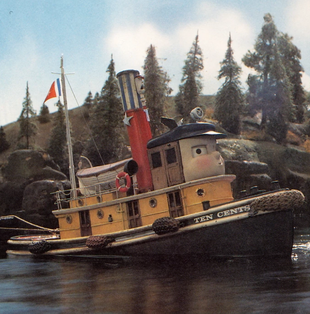
Image taken from the Tugs Wiki. Used under Fair Use.
Tugs is described by the Tugs Wiki as the main protagonist of the show. Ten Cents is a switcher, which means he is built for working in ports and not go onto the ocean. Tugs, like the other Star Tugs, is based on tugs that worked in San Francisco, which is why he's name Ten Cents. Despite having an American basis, he is a British tug.
No. 2 Big Mac
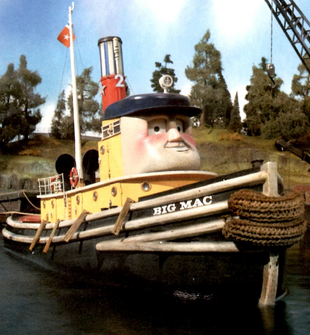
Image taken from the Tugs Wiki. Used under Fair Use.
Big Mac is one of the heavier haulers of the Star Tugs, and is often one of the more level headed members of the fleet. He does have a temper, and can be easily distracted when someone insults his friends. He can often be gruff and be easily annoyed by other members of the fleet, such as No. 5.
No. 3 O. J.
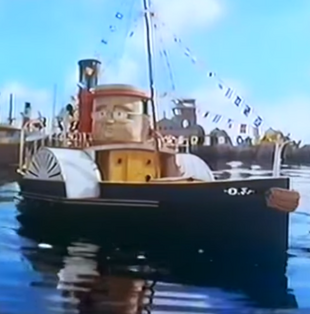
Image from the Tugs Wiki. Used under Fair Use.
O. J. is the oldest member of the Star Tugs, and the last paddle tug used in Bigg City Port. O. J. is the wisest member of the Star Tugs and when he can't always help with his strength, he can provide his wisdom. O. J. stands for Old Jones, according to the Tugs Wiki. O. J. is often trusted by Captain Star to oversee tasks.
No. 4 Top Hat
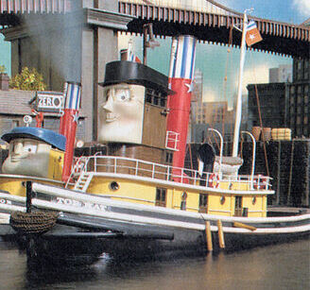
Image from the Tugs Wiki. Used under Fair Use.
Top Hat is the smug member of the Star Tugs, and normally complains about some of his jobs, in particular garbage runs. He is a hard worker, but does come off as a Posh snob, and even the Star Tugs will get annoyed with him.
No. 5 Warrior
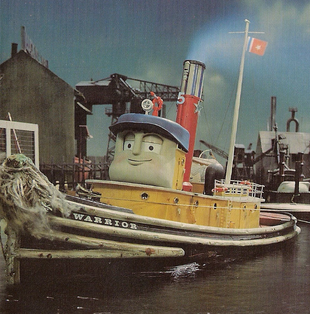
Image from the Tugs Wiki. Used under Fair Use.
Warrior could be described as the dumbest member of the Star Tugs. I like to see him more as a special needs representation. Warrior is stronger than he is smart, but he does prove himself to be smarter than other tugs give him credit. This' shown in particular in the last episode of the show, Big Freeze, when he sets Garbage on fire to give an important ship, the Vienna, a light to come in safely.
No. 6 Hercules
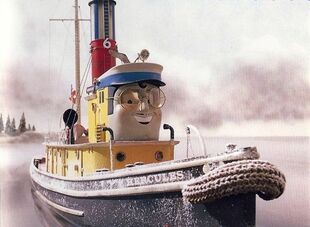
Image from the Tugs Wiki. Used under Fair Use.
Hercules is the largest and strongest member of the Star Tugs. He isn't seen in the show a lot, and only appears for small appearances towards the beginning or ends of episodes. Hercules is an ocean going tug, and his main work includes answering rescue calls and bringing in ships to port. Hercules often helps lead the tugs in operations in and out of the port.
No. 7 Sunshine
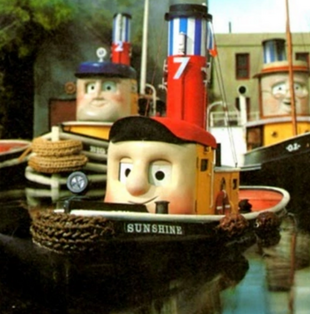
Image from the Tugs Wiki. Used under Fair Use.
Sunshine is the newest tug member of the Star Fleet. He is also the smallest and most inexperienced. Sunshine appears in the first episode of Tugs (spoilers for Tugs Episode 1: Sunshine)
In his first appearance Sunshine is a new tug who is being put on trial to help out the Star Fleet. He used to work up River, and knows a lot about the operations up river, which comes in handy in Episode 13 Big Freeze.
Sunshine often works with Ten Cents, and the two appear to be best friends. Together the small switchers can complete a lot of jobs.
There is another member, but again, Spoilers for Tugs.
Grampus
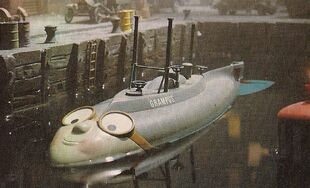
Image from the Tugs Wiki. Used under Fair Use.
Grampus is a Navy Submarine who is based in Bigg City Port. He is friends with the Star Tugs and helps out anyone in need, which we see in the episodes Pirate and Regatta. Grampus is saved by the Star Tugs when he is withdrawn from the Navy in Regatta. Grampus is known for accidentally spitting water into other Tug's faces when he resurfaces.
The Zed Stacks consist of 5 tugs, making them smaller than the Star Tugs.
No. 1 Zorran
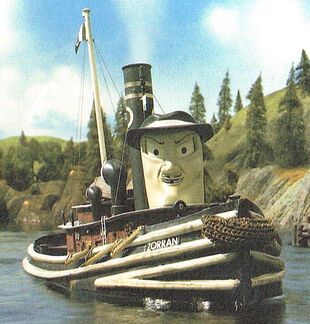
Image from the Tugs Wiki. Used under Fair Use.
Zorran is the main antagonist of Tugs, and is the de facto leader of the Zed Stacks. Zorran often attempts to plan up schemes to help the Zed Stacks get ahead of their competition, but this usually backfires on him.
No. 2 Zebedee
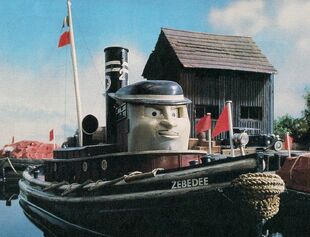
Image from the Tugs Wiki. Used under Fair Use.
Zebedee is arguably the most "good" of the Zed Stacks. At the least he's as the Tugs Wiki describes him, a "conflicted" character. Zebedee is much less antagonist than the other Zed Stacks, but always sides with his fleet, and is described as Zorran's right hand tug. Zebedee often works with Zak, and the two could be described as best friends.
No. 3 Zak
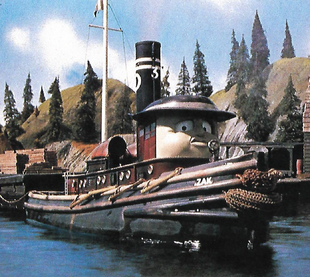
Image from the Tugs Wiki. Used under Fair Use.
Are you starting to notice a trend with the names of the Zed Stacks? That's right, they all start with Z.
Let's get back to Zak. Zak, unlike his friend Zebedee, is a callous thug, who is willing to go along with Zorran's schemes.
No. 4 Zug
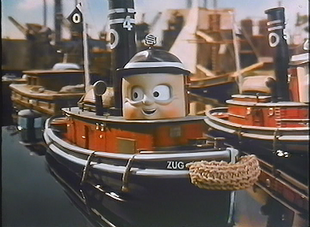
Image from the Tugs Wiki. Used under Fair Use.
Zug attempts to create schemes like Zorran, but his usually fail more quickly than Zorran's. He's not as confident as Zorran or the other Zed Stacks. Zug can easily be panicked when pushed too hard, in particular by Zorran.
No. 5 Zip

Image from the Tugs Wiki. Used under Fair Use.
Non-Tug Fleet Characters
All right, to keep this from being too long of a blog post, I will just name a few non tug characters, and leave out their pictures (if you are curious, I will leave a link to the Tugs Wiki).
Other recurring characters are Billy Shoepack, the alligator tug (who moves close to the water) who is a demolition "expert" if you can call him that. He does attempt to help, using explosives, which often leads to shenanigans.
Another character is Puffa, a steam locomotive who is friends with the Star Tugs. Puffa, unlike characters in Thomas & Friends, does not have a face. Like Captain Star, Puffa speaks using a megaphone.
Show Run
Clearwater Features took a year to make the first season of Tugs, which consisted of 13 episodes, from 1987 to 1988. The show began running on Children's ITV in the UK, Australia, Finland, Singapore, Brunei, France, France and Japan. For some reason the show, unlike Thomas, was not sent overseas to North America.
A second season was planned for Tugs, but unfortunately this never happened. Clearwater Features closed on New Year's Eve, 1990. Television South, which owned the rights to Tugs, would also go bankrupt, according to the Star Tugs Trust website.
Now, the rights to who owns Tugs today is super complicated. After TVS closed, Robert Cardona retained 50% of the rights, the the other 50% belonged to Castle Communications, who distributed VHS tapes of Tugs. Britt Allcroft almost saved the show, but this sadly did not happen. Which is truly sad when you learn what the Tugs were used for next. First, let's discuss the use of the models.
Later use of the Models
After Tugs shut down, David Mitton would return to Thomas and Friends, and Britt Alcroft would purchase the Tugs models, using them from 2001 to 2008, when the show would switch to CGI. The models were heavily modified for their appearances in Thomas and Friends. O. J., for example had his face removed and was renamed "Lakesider III," and appears in the Thomas episode "Peter Sam & the Refreshment Lady." O. J. wears this guise to this day.
In 1995, Cardona (who was now working in Canada) and Castle Communications sold the 50% stake of the rights to Tugs to Sunbow Productions. They would use the Tugs footage to create....
Salty's Lighthouse (Or, the WORST thing to happen to Tugs)
Sunbow Productions created the educational show called Sunbow Productions, which ran from 1997 to 1998. The main character of the show, a young boy named Salty (not the same character from Thomas) who lives with his friends in his lighthouse. Salty's Lighthouse is universally hated by Tugs fans (such as myself). The original voice actors were dubbed over, Salty's Lighthouse renamed Big Mac Big stack, OJ became Otis (probably due to O. J. Simpson), Zebedee was called Zeebee, Sunshine was voiced over and turned into a girl, who is Ten Cents' sister....what? The show was "babied" and dumbed down. Bigg City Port was also renamed to "Snuggleboat Harbour." Ugh.
Down the Rights Rabbit Hole
Apparently Cardona regretted selling the rights, and tried to get Castle Communications to buy the rights back to get Tugs VHS tapes recirculating. Unfortunately Castle Communications decided to focus more on music. Eventually Castle Communications would become the Sanctuary Group, and signed Indie band Keane, and were later bought out by Universal.
As for Sunbow Productions, they were bought by Sony Wonder, a division of Sony Music in 1998, and the TV Productions were sold to German company TV Toonland in 2000 for $20 million (US). They certainly didn't buy Sunbow Productions for Tugs. According to the Transformers Wiki, Sunbow Productions had the rights to several Hasbro cartoons, including Transformers (G1) and G. I. Joe.
In 2008, TV Toonland began to go under, so they sold the rights to the Hasbro series back to Hasbro for $7 million, and in 2009 they went bankrupt. The non-Hasbro rights were sold to m4e in 2011.
Here's the crazy thing though....I recently checked m4e's website, in particular their library of IP's. While Salty's Lighthouse is included, Tugs is nowhere to be seen. I tried searching Tugs on their website as well, with no results So who owns it? I would assume m4e, but they may not know it? Which might mean, pulling on my Public Domain Cap, that it would possibly make Tugs an "Orphan Work," where the owner does not know they own it. (Sh.... don't tell m4e).
Online Fandom & Legacy
Tugs would have been a forgotten series, if not for the internet. Thanks to YouTube, all of the 13 episodes of Tugs have been uploaded by fans from VHS tapes, and the fandom began to grow. In a way the Tugs Fandom, like the show, is a sister Fandom to Thomas and Friends. The fandom started in 2002, and was boosted by the Thomas Fandom.
There has also been fan projects of Tugs. The biggest was TUGS Audio Productios, which gained praise from composer Mike O'Donnell.
There were plans for a CGI fan made series, but this has not progressed.
One of the newest Tugs projects is the Stories of Sodor (which includes Ten Cents). Victor Tanzig, the creator of the show, took the show's premise and changed it to include characters from Thomas and Friends. Currently Mr. Tanzig is on hiatus while he works on his real life job and takes care of his mental health. If you are interested in seeing his first 3 seasons, you can check out his YouTube channel here: www.youtube.com/user/Ectcanaseremptus
The Star Tugs Trust
The fate for the models of the Tugs is a happy one. After model production of Thomas & Friends ended, the models went to the company with the largest stake in them (m4e I believe?) The Chairman of the Company didn't want to see the models thrown away, and asked the board to store them. They weren't interested in this, so the Chairman took the models home with him, and kept them until 2010.
The Chairman got in contact with with a man named Richard who could restore the Tugs models, and he began the work until 2012. The models, still in the UK, were taken to Norwich for restoration by Richard, a boat enthusiast, who saw it as a retirement project. Circumstances would change. At some point, the Chairman sold the models to Richard. In November 2012, Richard approached a group of fans to help him send the Tugs to good homes, such as people behind the show.
However, there was the risk the collection being dispersed and models lost to the public. So the Star Tugs Trust was founded. On January 26, 2013, the Star Tugs Trust met at the Brook Hotel in Norwich to take over ownership of the models.
The Star Tugs Trust owns a coach and displays the models at the Midland Railway in Butterfly, Derbyshire. The Tugs have been displayed at other locations as well. At the date of writing, the Star Tugs Trust has displayed the Tugs models in 10 different locations, and the list shall keep growing.
Many of the cast members, David Mitton, Robert D. Cardona have passed. Mike O'Donnell and Junior Campbell are still alive. I am not sure how active they are in interacting with fans, and do not believe they interact with either the Thomas or Tugs Fandom.
All right, that's all the information I have on Tugs, before you go, here's some fun facts!!
Fun Facts:
Shepperton Studios is still used today, according to the Pinewood Group. According to Film London.org, Harry Potter was filmed here.
Tugs fans thought that Dem Der Rocks was Dender Rocks, until corrected in an interview with a staff member with The Star Tugs Company.
The Tugs' whistles have mouths, for some reason. It took me a very long time to notice this, and I didn't realize it until it was pointed out in a video.
Despite what you might think, Big Mac was not named after the Big Mac sandwich of McDonald's. According to Big Mac's bio on Tugs Wiki, his name refers to his Scottish heritage. Big Mac was renamed Big Stac for the American show Salty's Lighthouse to avoid a lawsuit with McDonald's. And looking back...I don't blame them.
Big Mac's smiling face was separated from his model and was not reunited with the model until 2014.
Grampus was based on the Plunger class of Submarine, named after USS Grampus (USS-4). The USS Grampus was sunk as a target in 1922, which was the basis for the episode Regatta.
A Grampus is a type of Dolphin, known as a Risso's Dolphin or Blunt Nose Dolphin.
Grampus rode on the same trolley as the tugs, but unlike them because of his size he could move up and down.
While the Star Tugs Company owns Grampus' face models, the location of his model, along with Top Hat's, is unknown.
The basis for the Zed Stacks was the Moran Tug Fleet of the 1920's.
In the episode Regatta, Big Mac pulls a barge with the Clearwater Features logo on it, which you can see below.
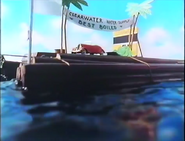
Image from the Tugs Wiki. Used under Fair Use.
BONUS FUN FACT!! Sorry I forgot to include this the first time. According to the Tugs Wiki, Robert Cardona would move to Canada and work on a similar show, Theodore the Tugboat, which was very similar to Tugs, but for a younger audience. I was introduced to Theodore first, and have fond memories of Theodore from my childhood. Maybe I'll do a similar post for Theodore in the future.
If you'd like to see a video of Tugs under production, check out this short video on YouTube. www.youtube.com/watch?v=kw7S3dpH68E
If you would like to watch the show, but don't know which episode to start with, please refer to this list on the Tugs Fandom Wiki. https://tugs.fandom.com/wiki/Episode_List
Thank you all for reading this blog post, and I hope you enjoyed it. I'm a big Tugs Fan myself, and I accidentally stumbled across it via YouTube, and I'm glad I did.
Personally, I'd love to do a reboot of Tugs, but not go the route David Mitton wanted to go, which was to move the series up river (because it was easier to film there than Bigg City Port). I would go with the idea of introducing new tugs, perhaps some female tugs, and keep the series focused in Bigg City Port, perhaps move the story from the 1920's into the 1930's and deal with the Great Depression.
All right, that's all for me in this post. It's been a long time coming (I had this planned back when I started the blog) and I'm glad to have it finished. Thanks for reading. Remember to keep writing and I'll see you on the Tramway!
Sources
"David Mitton." Tugs Wiki. https://tugs.fandom.com/wiki/David_Mitton
"Dem Der Rocks." Tugs Wiki. https://tugs.fandom.com/wiki/Dem_Der_Rocks
"Program Library." m4e. www.m4e.de/en/program-library
"Robert D. Cardona." Tugs Wiki. https://tugs.fandom.com/wiki/Robert_D._Cardona
"Salty's Lighthouse." Tugs Wiki. https://tugs.fandom.com/wiki/Salty%27s_Lighthouse
"Shepperton Studios." FilmLondon.org http://filmlondon.org.uk/shepperton-studios
"Shepperton Studios: Stages & Facilities" Pinewood Group.
www.pinewoodgroup.com/studios/shepperton-studios/stages-facilities
"TV Toonland." Transformers Wiki. https://tfwiki.net/wiki/TV-Loonland
